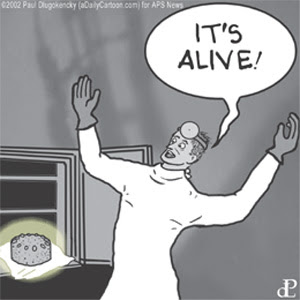
Fruitcake Science Festival;
The Science Museum of Virginia conduct unconventional science experiments on fruitcake as an annual holiday event on 26 December.- 30 December. Fruitcakes are burnt, dropped from great heights and even nitrogen frozen all in the name of science. In one demonstration, a museum educator found that fruitcake was so dense that all attempts of burning, freezing, and beating made much difference to the cake. “Fruitcakes are like
cockroaches, they’ll survive pretty much anything,” said Kramer, a science
educator at the museum.
Fruitcake Physics: For a more practical approach to fruitcake science experiments, Professor Braham of University of Bristol examines the crystal structure of molecules of food while it's being baked. Barham's experiments probably tell us exactly what we already know from experience - fruticake tastes better when it's aged. " The skins of dried fruits contain the same tannins that age red wines, creating complex flavours that young wines--and fruitcakes--lack. Moreover, the high sugar content of homemade cakes prevents bacterial growth, although Barham warns that some commercial fruitcakes might not survive the ageing process. He recommends ageing only those that are expected to last more than a month or two. "Look at the use-by date," says Barham. "If it's 6 months away, it might as well be 6 years."
There are of course other scientists who argue that an aged fruticake might have better flavour, but it still can become dry but Barham claims that by wrapping a seemingly dry cake in foil and heating it gently, the cake's starch crystals will be disrupted, and restore the cake to its freshness.
Interesting that cookbook author Dolores Casella, without science, has her own method of handling a stale, dry fruitcake. "Pour a liberal amount of brandy over it and allow a day or two for it to soak in," she says.
School Science : I am not sure how excited students would be about an experiment, consistent with the Australian Standard Curriculum, called Fruitcake Mining. The experiment aims to simulate issues related to extracting different minerals and deals with the environmental impact of mining. The children are asked to estimate the value of their mine lease (fruitcake), with different fruit representing different minerals e.g. SULTANA $0.85; FRUIT RIND $0.90; CHERRY $1.10
The students are then asked to extract the minerals (fruit) with tweezers and toothpicks, and then calculate the results of mining - its commercial value. The next step is to reshape what is left as close as possible to its original shape and suggest how the environmental impacts might be minimised ? from Oresome Resources
I would never have used the adjective" educational" associated with "fruitcake", but here are just a few examples of the fruitcake's contribution to science.
Tomorrow, multicultural fruitcake.



Comments
Post a Comment
Thanks for reading my blog and please share your thoughts about my blog post by leaving a comment.Your comment won't appear immediately as comments are verified before publication in an effort to reduce the amount of spam appearing. Anonymous comments will not be published.